India
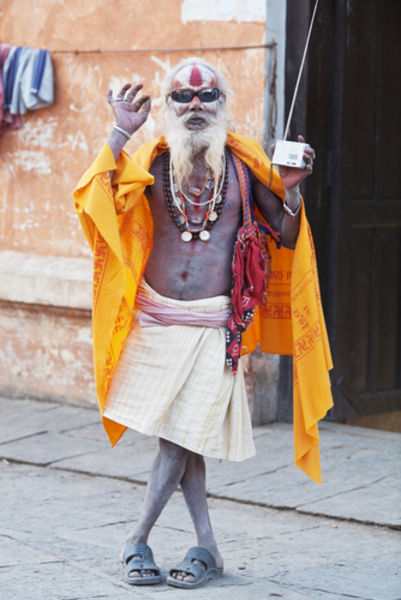
Basic Data
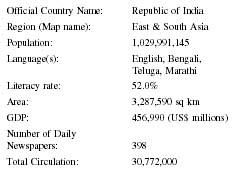
| Official Country Name: | Republic of India |
| Region (Map name): | East & South Asia |
| Population: | 1,029,991,145 |
| Language(s): | English, Bengali, Teluga, Marathi |
| Literacy rate: | 52.0% |
| Area: | 3,287,590 sq km |
| GDP: | 456,990 (US$ millions) |
| Number of Daily Newspapers: | 398 |
| Total Circulation: | 30,772,000 |
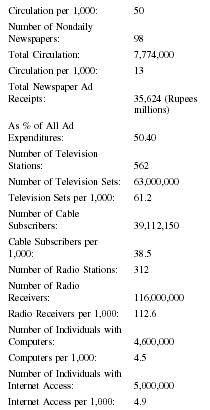
| Circulation per 1,000: | 50 |
| Number of Nondaily Newspapers: | 98 |
| Total Circulation: | 7,774,000 |
| Circulation per 1,000: | 13 |
| Total Newspaper Ad Receipts: | 35,624 (Rupees millions) |
| As % of All Ad Expenditures: | 50.40 |
| Number of Television Stations: | 562 |
| Number of Television Sets: | 63,000,000 |
| Television Sets per 1,000: | 61.2 |
| Number of Cable Subscribers: | 39,112,150 |
| Cable Subscribers per 1,000: | 38.5 |
| Number of Radio Stations: | 312 |
| Number of Radio Receivers: | 116,000,000 |
| Radio Receivers per 1,000: | 112.6 |
| Number of Individuals with Computers: | 4,600,000 |
| Computers per 1,000: | 4.5 |
| Number of Individuals with Internet Access: | 5,000,000 |
| Internet Access per 1,000: | 4.9 |
Background & General Characteristics
India is the world's largest democracy. Its mass media culture, a system that has evolved over centuries, is comprised of a complex framework. Modernization has transformed this into a communications network that sustains the pulse of a democracy of about 1.1 billion people. India's newspaper evolution is nearly unmatched in world press history. India's newspaper industry and its Westernization—or mondialisation as French would call it—go hand in hand. India's press is a metaphor for its advancement in the globalized world.
The printing press preceded the advent of printed news in India by about 100 years. It was in 1674 that the first printing apparatus was established in Bombay followed by Madras in 1772. India's first newspaper, Calcutta General Advertise , also known as the Hicky's Bengal Gazette was established in January 1780, and the first Hindi daily, Samachar Sudha Varshan , began in 1854. The evolution of the Indian media since has been fraught with developmental difficulties; illiteracy, colonial constraints and repression, poverty, and apathy thwart interest in news and media. Within this framework, it is instructive to examine India's press in two broad analytical sections: pre-colonial times and the colonial, independent press (which may, again be classified into two: preceding and following the Emergency rule imposed by Indira Gandhi's government in 1975). The post-Emergency phase, which continues at the present, may be the third independent phase of India's newspaper revolution (Jeffrey).
The Nature of the Audience
While a majority of the poor working people in rural and urban areas still remain oppressed and even illiterate, a significant proportion of people—roughly about 52 percent of the population over 15 years of age were recorded as being able to read and write. That breaks down to 65.5 percent of males and an estimate of 37.7 percent of females. After the liberalization of the economy, the growth of industry, and a rise in literacy, the post-Emergency boom rekindled the world's largest middle class in news, politics, and consumerism. Since private enterprise began to sustain and pay off, mass communications picked up as a growth industry.
In 1976, the Registrar of Newspapers for India had recorded 875 papers; in 1995 there were 4,453. Robin Jeffrey comments:
"Newspapers did not expand simply because the technology was available to make Indian scripts live as they had not been able to live before. Nor did newspaper grow simply because more people knew how to read and write. They grew because entrepreneurs detected a growing hunger for information among ever-widening sections of India's people, who were potential consumers as well as newspaper readers. A race began to reach this audience advertising avenues were the prizes and these would come largely to newspapers that could convince advertisers that they had more readers than their rivals. Readers, meanwhile, were saying implicitly: 'We will read newspapers that tell us about ourselves and reflect our concerns." (48)
Common contenders for readership and advertising are: the National Herald, the Hindustan Times, Time, Illustrated Weekly, e Pioneer, and Filmfare.
Historical Traditions
"Newspaper history in India is inextricably tangled with political history," wrote A. E. Charlton (Wolseley 3). James Augustus Hicky was the founder of India's first newspaper, the Calcutta General Advertiser also known as Hicky's Bengal Gazette , in 1780. Soon other newspapers came into existence in Calcutta and Madras: the Calcutta Gazette , the Bengal Journal, the Oriental Magazine , the Madras Courier and the Indian Gazette . While the India Gazette enjoyed governmental patronage including free postal circulation and advertisements, Hicky's Bengal Gazette earned the rulers' wrath due to its criticism of the government. In November 1780 its circulation was halted by government decree. Hicky protested against this arbitrary harassment without avail, and was imprisoned. The Bengal Gazette and the India Gazette were followed by the Calcutta Gazette which subsequently became the government's "medium for making its general orders" (Sankhdher 24-32).
The Bombay Herald , The Statesmen in Calcutta and the Madras Mail and The Hindu , along with many other rivals in Madras represented the metropolitan voice of India and its people. While Statesman voiced the English rulers' voice, The Hindu became the beacon of patriotism in the South. The Hindu was founded in Madras as a counter to the Madras Mail .
Patriotic movements grew in proportion with the colonial ruthlessness, and a vehicle of information dissemination became a tool for freedom struggle. In the struggle for freedom, journalists in the twentieth century performed a dual role as professionals and nationalists. Indeed many national leaders, from Gandhi to Vajpayee, were journalists as well. Calcutta, Madras, Bombay and Delhi were four main centers of urban renaissance which nourished news in India. It was only during and after the seventies, especially after Indira Gandhi's defeat in 1977, that regional language newspapers became prevalent.
There were nationalist echoes from other linguistic regional provinces. Bengal, Gujarat, Tamil, Karalla, Punjab and Uttar Pradesh produced dailies in regional languages. Hindi and Urdu were largely instrumental in voicing the viewpoints and aspirations of both Hindus and Muslims of the Northern provinces. As communalism and religious intolerance increased before and after partition, Urdu remained primarily the language of Muslims, as Pakistan chose this language as its lingua franca. After partition, the cause of Urdu and its newspapers, suffered a setback as Hindu reactionaries began to recognize the association of Urdu with Islam and Pakistan.
Diversity and the Language Press
Naresh Khanna summarizes the trends in circulatory growth and decline varied in regional language papers during 1998-2000: In the three-year period from 1998-2000, circulation of dailies in the country increased marginally from 58.37 to 59.13 million copies. This represents a growth of 1.3 percent on the basis of data published by the Registrar of Newspapers for India in its annual reports. In this time, two distinct groups of newspapers emerge — the first including five languages that have collectively grown in
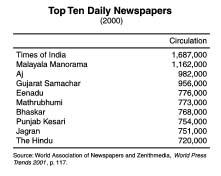
The second group of stagnating and declining circulations includes newspapers in seven languages with a combined circulation of 14.8 million copies in 2000. These dailies lost almost 1.8 million copies (10.62 percent) of their combined circulation in the last three years. Daily newspaper circulation plummeted most dramatically in Telugu, which fell from 2.28 million to 1.68 million copies, a fall of more than 26 percent. Urdu newspaper circulation fell by more than 12 percent and Tamil dailies' circulation declined by 10.8 percent with circulation of Gujarati dailies falling by 10.5 percent. Over the same period circulations of Oriya dailies declined by 2.8 percent and that of Punjabi dailies by 3.2 percent. Although over the three years Kannada newspapers show an insignificant fall in circulation they seem to have entered a period of stagnation and decline of their own. It would seem that in spite of new editions being added by Hindi, English, Malayalam and Bengali dailies, the print media is losing its dominance of advertising market share to television, radio and outdoor media (Khanna 2002).
Economic Framework
India's language newspapers enjoy a relatively new entrepreneurial prowess. A mutually convenient relationship between the owners and capitalists keeps a financial balance between local/regional and national spheres in both private and public sectors. "Like coral in a reef, newspapers grew and died in a process inseparable from the creation of a 'public sphere' in the classical liberal sense. Individual proprietors sometimes brought to their newspapers a crusader's zeal for a particular cause or a diehard's loathing for a rival" (Jeffrey 105). The Second Press Commission in 1982 tried to liberate the press from the monopoly houses. In 1995 the Audit Bureau of circulations had 165 newspapers as members, with a combined circulation of about 16 million copies a day. The top ten newspapers control roughly 50 percent of daily circulations in all languages. Bennett Coleman and the Indian Express own roughly 20 percent of daily circulations (Jeffrey 108).
While capitalists sustained national newspapers, the big houses, Dalmias, Jains, Goenka et al., monopolized and corrupted free journalism. The family and caste controlled small newspapers regionally maintain their freedom from big monopolies, thriving on their loyal supporters in north and south India. Diversity of ownership is reflective of cultural variation in India's multilingual landscape. Twenty-one newspapers control two-thirds of all circulations.
Press Laws
Much of India's legal framework is built upon its colonial legacy. Legal statutes and regulations have been undergoing certain changes as India's democracy grows. India's freedom came at a high cost. The country was divided. India's border conflicts with two hostile neighbors, which forced at least three large scale wars, eclipsed other political issues. The democratic process, corrupted by criminals, unscrupulous bureaucrats and politicians, created a social climate that widened social and economic inequality.
Freedom of speech and expression is a constitutionally guaranteed fundamental right of the Indian people. Article 19 (1; a) ensures the implicit freedom but Article 19 (2) qualifies this in explicit terms. The Parliamentary Proceedings (protection of Publication) Act of 1977 and the Prevention of Publication of Objectionable Matter (Repeal Act) of 1977 further reinforce and restrict these freedoms. While constitutional guarantees ensure freedom of the press and expression, press and media are obligated by a self-regulatory system of ethics that protect individuals and organizations from libelous behavior. "Freedom of the press is an institutional freedom," wrote Sachin Sen (19). The Press Council Bill of 1956, introduced in the Indian parliament, stipulated the establishment of the Press Council of India representing working journalists, the newspaper management, literary bodies and the Parliament. The Indian Press commission

While The Central Press Accreditation Committee seeks to ensure quality and self-renewal, The Press Council of India was established in 1966 to uphold editorial autonomy. Restrictions on free speech were imposed after Indira Gandhi's infamous Emergency rule. The Press Council of India was abolished after editor George Verghese's criticisms of the Indira government. The Ministry of Information and Broadcasting carefully regulates the press and its liberties. The Maintenance of Internal Security Act (MISA) was enforced to intimidate reputedly autonomous newspapers in the seventies. The Press Council, resurrected in 1979, has no legal standing to impose penalties. The Indian press, generally believed as "managed," is a self-restrained institution generally reluctant to take on the governmental policies. All India Radio (AIR) and its management exemplify this "man-aged" system.
The Registrar of Newspapers
The Registrar of Indian newspapers, among these official and professional agencies, regulates and records the status of newspapers. Electronic news, Web sites, magazines and house publications, and a number of professional organizations (like Editors Guild of India, Indian Language Newspapers' Association, and All India Newspapers Editors' Conference etc.) enrich the self-renewal process of the news enterprise. Educational and training programs are gaining importance as professionalization of specialized fields is a prioritized activity under the privatization process.
The Office of the Registrar
The Office of the Registrar of Newspapers for India, popularly known as RNI came into being on July 1, 1956, on the recommendation of the First Press Commission in 1953 and by amending the Press and Registration of Books Act (PRB Act) 1867. The functions of RNI involve both statutory and non-statutory functions.
Statutory Functions The RNI compiles and maintains a register of newspapers containing particulars about all the newspapers published in the country; it issues certificates of registration to the newspapers published under valid declaration. It scrutinizes and analyzes annual statements sent by the publishers of newspapers every year under Section 19-D of the Press and Registration of Books Act containing information on circulation, ownership, etc. The RNI informs the District Magistrates about availability of titles to intending publishers for filing declaration and ensures that newspapers are published in accordance with the provisions of the Press and Registration of Books Acts. It verifies under Section 19-F of the PRB Act of circulation claims, furnished by the publishers in their Annual Statements and Preparation and submission to the Government on or before September 30 each year, a report containing all available information and statistics about the press in India with particular reference to the emerging trends in circulation and in the direction of common ownership units.
Non-Statutory Functions Non-statutory functions of the RNI include the formulation of a Newsprint Allocation Policy—guidelines and the ability to issue Eligibility Certificates to the newspapers to enable them to import newsprint and to procure indigenous newsprint. The RNI assesses and certifies the essential needs and requirements of newspaper establishments to import printing and composing machinery and allied materials.
From April 1998 to February 1999, RNI scrutinized 18,459 applications for availability of titles, of which 7,738 titles were found available for verification, while in the remaining applications, titles were not found available. During the same period, 2,693 newspapers/periodicals were issued Certificates of Registration (2,145 fresh CRs and 548 revised CRs) and circulation claims of 1536 newspapers/periodicals were assessed.
Newsprint
Until 1994-95, newsprint allocation was regulated by the Newsprint Control Order (1962) and the Newsprint Import Policy announced by the government every year. Newspapers were issued Entitlement Certificates for importation and purchase from the scheduled indigenous
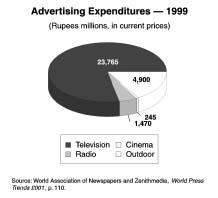
De-Blocking of Titles
For the first time in the history of RNI, a massive work of de-blocking 200,000 titles was undertaken. As per the decision, all such titles of newspapers were certified till December 31, 1995, and those publications which had not registered with RNI have been de-blocked.
The work of entering registered titles has been completed and the lists have been dispatched to state governments. Nearly 150,000 of unused titles have become available for allocation to other newspapers from January 1, 1999.
Printing Machinery
The RNI is the sponsoring authority for the import of printing machinery and allied materials at the concessional rate of custom duty available to the newspapers. During April 1998-February 1999, applications of four newspaper establishments were recommended for import of printing machinery and allied equipment.
Censorship
Even though India is committed to the freedom of the press, censorship is not unknown to the media. With increased privatization and entrepreneurial advancements, colonial and bureaucratic censorship no longer exists. However, the nexus of criminal politics and unethical monopolies continue to threaten the freedom of press.
Nehru famously said: "I would rather have a completely free press with all the dangers involved in the wrong use of that freedom than a suppressed or regulated press" (quoted by Kamath 272). After 1977 people's interest and involvement in regional and national affairs increased dramatically. This development helped promote the dualism of India's patriotic passions marked by linguistic chauvinism and national unity.
State-Press Relations
Public Grievances
A Public Grievances Cell is functioning in the Main Secretariat of the Ministry headed by the Joint Secretary (Policy). In order to tone up the Grievance Redressal System of the Ministry, its time limits have been fixed for completion of various activities coming under the purview of the grievance redressal mechanism. Grievance Officers have been appointed in all the subordinate organizations of the Ministry who have been made responsible for timely redress of grievances. Keeping in view the need for effective monitoring of the progress in the grievance redressal, the Ministry has developed a computerized Grievance Monitoring System. The grievances received in the Ministry are sent to the concerned Grievance Officer in the attached subordinate offices of the Ministry. Periodical review meetings are held in the Ministry to ensure that the grievances are processed within a stipulated time limit.
Attitude Toward Foreign Media
India is a founding member of the United Nations Educational, Scientific, and Cultural Organization (UNESCO). UNESCO's main goal is to promote international cooperation in the field of education, science and technology, social sciences, culture and mass communication. In order to promote the communication capabilities of developing countries. The 21st Session of the General Conference of UNESCO in 1981 approved the establishment of an International Program for the Development of Communication (IPDC). India played a significant role in its inception and has been a member of the Inter-governmental Council (IGC) and also of the IPDC Bureau. India has played a leading role in its activities over the years. Being one of the founding members of IPDC, this Ministry has been a representative at the meetings of the General Conference of UNESCO and Bureau Session of IPDC.
India participated in the First South Asian Association for Regional Cooperarion (SAARC) Information Ministers Meeting held in Dhaka (Bangladesh) in 1998. The Meeting discussed the need for greater cooperation among media personnel, cooperation among news agencies, improving the programs under SAARC Audio Visual Exchange, and taking steps to project SAARC outside the region.
More indications of India's support of international cooperation is its participaton in the meeting of Asia-Pacific Regional Experts on the Legal Framework for Cyberspace from 8 to 10 September 1998 and the Third Regulatory Round Table for the Asia and the Pacific at Seoul from 14 to 16 September 1998 for finalizing the report on Trans-border Satellite Broadcasting.
News Agencies
News agencies provide regularity and authenticity to news. K.C. Roy is credited with establishing the first Indian news agency, which became The Associated Press of India (API). However, it soon became a British-controlled agency unwilling to report about the national freedom movement. The Free Press of India News Agency came into existence under the management of S. Sadanad who had served Reuters. The United Press of India, The Orient Press, The Globe News Agency, The NAFEN News Agency, The United News of India and a number of syndicates later came to serve the news business.
The Non-aligned News Agencies Pool (NANAP), formally constituted in 1976 for the purpose of correcting imbalances in the global flow of information, is an arrangement for exchange of news and information among the national news agencies of non-aligned countries, including Asia, Africa, Europe and Latin America. Its affairs are managed by a coordinating committee elected for a term of three years. India is at present a member of the coordinating committee. The cost of running the pool is met by the participating members. The Press Trust (PTI) continued to operate the India News Pool Desk (INDP) of the NANAP on behalf of the government of India. India continued to contribute substantially to the daily news file of the Pool Network. The reception of news into the Pool Desk during the year 1998-99 has been in the range of 20,000 words per day. INDP's own contribution to the Pool partners during the year has averaged 7,000 words per day.
The organization and structure of Indian news agencies has been undergoing a controversial transformation for quite sometime. This represents a mutual mistrust between privately owned news agencies and governmental structures. Their autonomy, believed to be crucial for objectivity and fairness, is based on their role as cooperatives and non-profit groups. News agencies in general are

Broadcast Media
The Ministry of Information & Broadcasting, through the mass communication media of radio, television, films, the press, publications, advertising and traditional modes of dance and drama, plays a significant part in helping the people to have access to information. It fosters the dissemination of knowledge and entertainment in all sectors of society, striking a careful balance between public interest and commercial needs in its delivery of services. The Ministry of Information & Broadcasting is the highest body for formulation and administration of the rules, regulations and laws relating to information, broadcasting, the press and films. The ministry is responsible for international cooperation in the field of mass media, films and broadcasting, and interacts with its foreign counterparts on behalf of Government of India. The mandate of the Ministry of Information & Broadcasting is to provide:
- News Services through All India Radio (AIR) and Doordarshan (DD) for the people
- Development of broadcasting and television
- Import and export of films
- Development and promotion of film industry
-
Organization of film festivals and cultural exchanges
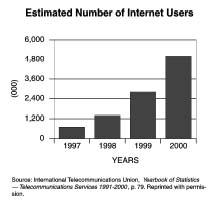
- Advertisement and visual publicity on behalf of the Government of India
- Handling of press relations to present the policies of Government of India and to seek feedback on government policies
- Administration of the Press and Registration of Books Act of 1867 in respect of newspapers
- Dissemination of information about India within and outside the country through publications on matters of national importance
- Research, reference, and training to assist the media units of the Ministry to meet their responsibilities
- Use of interpersonal communication and traditional folk art forms for information/publicity campaigns on public interest issues
- International co-operation in the field of information and mass media
The main Secretariat of the Ministry is divided into three wings: the information wing, the broadcasting wing, and the film wing. The media units engaged in press and publicity activities include:
- Press: 1) Press Information Bureau; 2) Photo Division; 3) Research Reference & Training Division; 4) Publications Division
- Publicity: 5) Directorate of Advertising and Visual Publicity; 6) Directorate of Field Publicity; 7) Song and Drama Division
- Regulation of the Press: 8) Registrar of Newspapers for India; 9) Press Council of India
- Training: 10) Indian Institute of Mass Communication (Government of India, 2002)
Electronic News Media
Most Indian newspapers, magazines, and media outlets are easily accessible through the Internet. Internet Public Library (IPL) is a concise Internet source for information on Indian newspapers. The Onlinenewspapers.com Web site lists about 120 online newspapers for India with access to each of those papers for reading.
The official Web site for the Library of Congress in New Delhi is also accessible on the Internet, where e-mail contact information is provided. This directory is published biennially. The directory includes newspapers published in India, the name and language of the newspapers, circulation, frequency of publication, and names and addresses for the publishers of each paper. Paper status is also included.
Internet Public Library's list of India's contemporary newspapers exists to enable instant access to existing information resources. Among them in 2002 were 62 Indian newspapers that were available online.
Education & TRAINING
The first diploma in Journalism was offered at Aligarh Muslim University in 1938 by the late Sir shah Muhammad Sulaiman, a Judge in India (Wolseley 224). Later on, after partition, universities in Punjab, Madras, Delhi, Calcutta, Mysore, Nagpur, and Osmania offered courses at undergraduate levels. Professional education in India is largely a need-based enterprise. Journalists and other mass communicators can perform without specialized training and skills, and can succeed without advanced degrees.
Summary
The media in India represents a confluence of paradoxes: tradition and modernity; anarchy and order; diversity and unity; conflict and cooperation; news and views; feudalism and democracy; the free market and monopoly.
Economic realities and relationships between press, television and those who own these engines of control and change will eventually determine the future of India's communication culture. India's complex cultural mosaic, especially linguistic and communal, strengthens its diversity. The media and press continue to play a dominant role in deconstructing the diversity discourse that sometimes flares up in explosive situations.
Capitalism, the press, and public hunger for news promote a culture of media that is fast replacing the legacy of a feudal/colonial system. While corporatization and state regulations can muffle free expression, the force of public interest and the market economy strive for greater freedom and openness. Both politics and capitalism thrive on the liberties of a democratic system that continues to evolve into a functional hybrid of chaos and order.
Significant Dates
- 1990: Nikhil Wagle publishes a Mumbai evening tabloid Hamara Mahanagar , 'Our great city' (January)
- 1991: Mahanagar is vandalized by a Shiva Sena gang
- 1995: The politician-proprietor of a Telgu daily embroiled in controversy was murdered, allegedly by the People's War Group (December)
- 1997: Dainik Bhaskar , the Bhopal-based Hindi daily opened a Jaipur edition, self-acclaimed its status as "India's Fastest Growing Newspaper"
Bibliography
Bhaskar, B.R.P. "Understanding the Language Press." Frontline, 2 March 2001.
Bhattacharjee, Arun. The Indian Press: Profession to Industry . Delhi: Vikas Publications, 1972.
Government of India. Ministry of Information and Broadcasting: Annual Report 2000-2001. Available from http://www.mib.nic.in .
Hamill, Pete. News Is a Verb . New York: The Ballantine Publishing Group, 1998.
Jeffrey, Robin. India's Newspaper Revolution . New York: St. Martin's Press, 2000.
Joseph, Ammu, and Kalpana Sharma. Whose News? The Media and Women's Issues . New Delhi: Sage Publications, 1994.
Kamath, M.V. Professional Journalism . New Delhi: Vikas Publishing House, 1980.
Khanna, Naresh. "Newspaper circulations in India 1998-2000." New Delhi, April 2002.
Mohan, B. Democracies of Unfreedom: The United States of America and India . Westport, CT: Praeger, 1996.
Murthy, N. Krishna. Indian Journalism . Mysore: Prasaranga, University of Mysore, 1966.
India: A Wounded Civilization . London: Penguin Books, 1987.
Naipaul, V.S. India: A Million Mutinies Now . London: Minerva, 1990.
Natrajan, S. A History of Press in India . New York: Asia Publishing House, 1962.
Nehru, Jawaharlal. The Discovery of India . New Delhi: Oxford University Press, 1982.
Parthasarthy, Rangaswami. Memoirs of a News Editor: Thirty Years With The Hindu . Calcutta: Naya Prokash, 1980.
Rau, M. Chalapathi. Journalism and Politics . New Delhi: Vikas Publishing House, 1984.
Sankhdher, B.M. Press, Politics, and Public Opinion in India: Dynamics of Modernization and Social Transformation . New Delhi: Deep & Deep Publication, 1984.
Segel, Ronald. The Crisis of India . Harmondsworth: Penguin, 1965.
Wolseley, Roland E. Ed. Journalism in Modern India . Bombay: Asia Publishing House, 1953.
Brij Mohan
important leaders and intellectuals of that era would be of much significance. Thanks
I found this to be very informative. I've used it in my project work about the Indain regional Journalism.
Thanks.
this article is really informative..I am preparing for my journalism entrances and its been quiet a help.
You are elegant
Happiness for you forever & i welcome you with my heart.
thanks
with regards
Vishal Sisodia
Editor
Nirnay aaj tak weekly news
The site gives valuable information. It has listed top 10 news-papers with highest circulation in the country.
However, I did not find details of circulation of regional news-papers like Gujarathi and Marathi news papers published from Mumbai and Pune.
I will be glad if you publish on the site, daily circulation of important Marathi, English and Gujarathi news-papers published from Mumbai, Pune, Western Maharashtra and Ahmedabad, Baroda in Gujarath. Atleast top 10 news-papers in each of these categories.
This will help us solve quesries of students in our Institutes of Journalism.
Will you/can you give these figures ?
thanks,
Avinash Bhome, Pune.
I am pursuing a degree in communication and Marketing, your article is excellent and will help me tremendously in my work. I just wanted to know the year of its publication as it is essential for us to provide all details. This is solely for academic purpose.
Thank you so much
Surbhi Mittal
thank you very much
Vijay Parthasarathy
President, Asia Pac Ops
Mast Mobile Media
thanks.
Thank you in advance.
Best Regards.
I WISH TO START A NEWS AGENCY AND A NEWS CHANNEL.
KINDLY GUIDE ME WHAT REGISTRATIONS AND APPROVALS I REQUIRE AND THE PROCEDURES OF GETTING NECESSARY APPROVALS.
In Karnataka few cities like Raichur city, the Kannada daily local papers only highlight politician news and their strikes also they couldn't care about public news ,opinion anything anti-strike news in their news paper. What kind of action take place to those type of local daily Kannada news papers. please tell me whom i complaint?
this has helped me alot for my project as well as general knowledge also
m looking forward for kinda a dis
please advise.
Your information given in the site is excellent and full of knowledge.
we r happy to know about this information.
thank you
I wish to start a news agency, what is the procedure for an authentic news agency establishment?
Your information given in the site is excellent and full of k